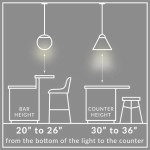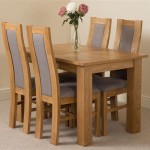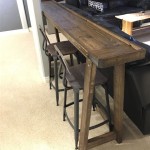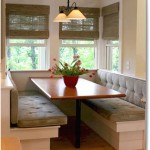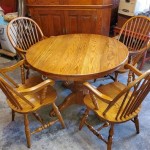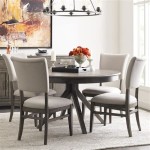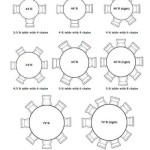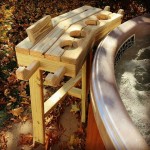Bench Seats For Kitchen Table: A Comprehensive Guide
The incorporation of bench seats at a kitchen table represents a design choice that blends functionality with aesthetic appeal. Unlike individual chairs, bench seating offers a unique set of advantages and considerations that can significantly impact the overall dining experience and the utilization of space within a kitchen or dining area. This article provides a detailed exploration of bench seats for kitchen tables, covering various aspects from design and materials to installation and maintenance.
Bench seating is a versatile option that has seen a resurgence in popularity. It can cater to diverse needs, from maximizing seating capacity in compact spaces to creating a more informal and communal dining atmosphere. Understanding the nuances of bench seat design, material selection, and spatial integration is crucial for making informed decisions and achieving desired outcomes.
Maximizing Space and Seating Capacity
One of the primary benefits of using bench seats with a kitchen table is the efficient use of space. In smaller kitchens or dining areas, benches can be tucked neatly under the table when not in use, freeing up valuable floor space. This is in contrast to individual chairs, which typically occupy a larger footprint even when pushed in.
Furthermore, benches offer a flexible seating arrangement. They can accommodate more people than individual chairs of equivalent width. This is particularly useful for families with children or for hosting larger gatherings. The ability to squeeze in an extra person or two on a bench can be invaluable when space is limited.
The adaptability of bench seating extends to various table shapes and sizes. Benches can be custom-built to fit specific table dimensions, ensuring a seamless and integrated look. This customization allows for optimal space utilization and a cohesive design aesthetic.
Consider the placement of the bench relative to the table. A bench placed against a wall can create a cozy nook, while a bench positioned along an open side of the table allows for easy access and exit. Careful planning of bench placement is essential for maximizing space and ensuring comfortable use.
The depth of the bench seat is another important factor to consider. A deeper bench provides more comfortable seating but requires more space. A shallower bench is more space-efficient but may be less comfortable for extended periods of sitting. Balancing comfort and space constraints is crucial for optimal design.
The height of the bench should also be carefully considered in relation to the table height. The ideal height difference between the bench seat and the table top should allow for comfortable legroom and easy reaching of food and drinks. A general guideline is to maintain a distance of approximately 10 to 12 inches between the top of the bench seat and the underside of the table.
Design Considerations and Material Selection
The design of a bench seat for a kitchen table should complement the overall style of the kitchen and dining area. Benches are available in a wide range of styles, from rustic and farmhouse to modern and minimalist. Choosing a design that aligns with the existing decor is crucial for creating a harmonious and aesthetically pleasing space.
Material selection plays a significant role in both the appearance and functionality of the bench seat. Wood is a popular choice for its durability, warmth, and versatility. Different types of wood, such as oak, maple, pine, and walnut, offer varying grain patterns and color tones, allowing for customization to suit different design preferences.
Upholstered benches offer enhanced comfort and a wider range of design possibilities. Upholstery materials can include fabric, leather, and vinyl, each with its own set of advantages and disadvantages. Fabric upholstery offers a soft and comfortable seating surface but may be more susceptible to stains and wear. Leather upholstery is durable and easy to clean but can be more expensive. Vinyl upholstery is a cost-effective and low-maintenance option, but it may not be as comfortable as other materials.
Metal benches offer a sleek and modern look. Metal frames are typically made of steel or iron and can be powder-coated in various colors. Metal benches are durable and easy to clean, making them a practical choice for high-traffic areas.
The finish of the bench seat is another important design consideration. A natural wood finish highlights the beauty of the wood grain, while a painted finish allows for customization and coordination with the kitchen color scheme. Consider the durability of the finish and its resistance to scratches and stains.
The legs of the bench seat should be sturdy and well-proportioned to the overall design. Different leg styles, such as tapered legs, straight legs, and hairpin legs, can significantly impact the aesthetic appeal of the bench. Ensure that the legs are properly attached and can support the weight of the users.
Consider adding a backrest to the bench seat for enhanced comfort and support. A backrest can provide a more relaxed seating experience, especially for longer meals. The height and angle of the backrest should be ergonomically designed to promote proper posture.
Installation and Maintenance
The installation of a bench seat for a kitchen table can vary depending on the design and construction of the bench. Some benches are freestanding and require no installation, while others may need to be attached to the wall or floor for added stability.
If the bench needs to be attached to the wall, it is important to use appropriate hardware and techniques to ensure a secure and stable installation. Locate the wall studs and use screws that are long enough to penetrate the studs. This will provide the strongest possible connection.
For freestanding benches, ensure that the legs are level and stable. If the floor is uneven, use shims to adjust the height of the legs and prevent wobbling. This will improve the comfort and safety of the bench.
Regular maintenance is essential for preserving the appearance and longevity of the bench seat. Clean the bench regularly with a damp cloth to remove dust and spills. Avoid using harsh chemicals or abrasive cleaners, as these can damage the finish or upholstery.
For wood benches, apply a wood polish or oil periodically to protect the wood from drying out and cracking. This will help to maintain the natural beauty of the wood grain.
For upholstered benches, vacuum regularly to remove dust and dirt. Spot clean any stains immediately with a mild detergent and water. Consider using a fabric protector to repel stains and spills.
Inspect the bench regularly for any signs of damage or wear. Tighten any loose screws or bolts. Repair any cracks or chips in the finish. Address any issues promptly to prevent them from worsening.
Consider the type of use the bench will receive. If it's used frequently by children, a more durable and easy-to-clean material might be preferable. If the bench is primarily for occasional use, comfort and aesthetic appeal might be prioritized over durability.
The overall ambiance of the kitchen should also be considered when selecting a bench. A rustic kitchen might benefit from a wooden bench with a distressed finish, while a modern kitchen might be better suited to a sleek metal bench or an upholstered bench with clean lines.
Ultimately, the decision to incorporate bench seating at a kitchen table should be based on a careful assessment of individual needs, preferences, and spatial constraints. By considering the factors outlined in this article, it is possible to make informed decisions and create a dining space that is both functional and aesthetically pleasing.

The Secret To Using Bench Seats In Any Dining Room

Banquette Seating Kitchen Dining And Table Bench Set Oak Etsy

How A Kitchen Table With Bench Seating Can Totally Complete Your Home

Pin Page

Wall Shop Bench Seating

Millbrooke Live Edge Acacia Wood Dining Table Bench Set

How A Kitchen Table With Bench Seating Can Totally Complete Your Home

Sit Back And Relax With Our Small Kitchen Banquette Seating Ideas
:strip_icc()/101207207-0c39fc7deece4b69af3777ae84a79250.jpg?strip=all)
Sit Back And Relax With Our Small Kitchen Banquette Seating Ideas

7 Reasons You Need A Dining Table Bench Set Only Oak Furniture

